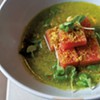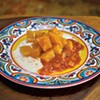Published November 10, 2009 at 5:49 p.m.
Surrounded by moving boxes, I tugged open a closet door and let out a groan. Behind the board games, DVDs and puzzle books sat six hefty piles of food magazines, lightly dusted and forgotten since I moved in two years before. Owning them makes me feel like I have the culinary world at my fingertips, but relocating them? That’s a bitch.
The hoarder in me refuses to get rid of volumes that could contain hidden treasures — now that Gourmet is defunct, those are keepers, for sure — but I knew I wasn’t wedded to every page. The recommendations in 8-year-old issues of Wine Enthusiast could no longer be trusted. Cooking Light offered more info about burning calories than consuming them.
So I grabbed a pair of scissors and got to work deciding which recipes made the, um, cut. The good stuff went into a shoebox that was already buckling under the weight of index cards bearing recipes for Bananas and Papayas Foster and Thai Basil Chicken Salad, an envelope scrawled with the method for preparing a German chocolate cake, and a slew of items from the King Arthur Flour and Williams-Sonoma catalogues. I tried to count the recipes and gave up at 500, with the shoebox still more than half full.
As I sifted through my collection, I realized its motley items had something in common: None of them were getting used. The world’s best roasted-red-pepper soup might be buried there and nobody would ever know. It was time for some serious recipe management.
Years ago, I created an Excel spreadsheet using my own nontraditional categories, formatted so each recipe had its own virtual “card.” But it was still tough to find exactly what I was looking for. Given that my current cellphone can perform more functions than did my computer back then, I concluded there must be a better way.
Before taking a new tack, though, I decided to ask some of my foodie Facebook friends how they keep their cooking under control. I found that, while my pack-rat problem is common, its solutions are as varied as the cooks.
******
At Martha Trombley Oakes’ bridal shower a decade ago, guests gave her handwritten copies of their favorite recipes. Her mother-in-law regularly mails clippings from magazines and newspapers, as well as methods for making dishes that Oakes’ husband, Shane, enjoyed as a child.
Now the director of corporate and community relations at National Life in Montpelier, Oakes admits she had issues with the haphazard way the recipes were presented to her. “I’m pretty organized in every aspect of my life. It’s a little obsessive,” she admits. “Quite honestly, it drove me crazy at first, because they were on all different sorts of note cards.”
But when she sat down to get the recipes organized once and for all, she found their personalized quality charming. “I realized I wanted to preserve the way I originally received the recipe, because I think it tells so much of the story,” says Oakes.
Her solution? Buying photo albums and slipping recipe cards in the picture slots. “I took the time to go through and evaluate which recipes were my favorites and which ones I’d never use,” she notes. The ones that made the grade are divided by course — appetizer, soup, side dish, main dish, etc. — with favorites placed at the front of each section.
Oakes now has two binders stuffed with recipes she knows she’ll actually make, and she exercises restraint in gathering new ones. “I see tons of recipes and think, Oh, my God, that’s amazing, but if I know I’m probably not going to actually use it, I won’t clip it,” she says, “because I hate clutter.”
Nicole Ravlin, a partner at Burlington marketing firm PMG, isn’t quite as strict as Oakes. She started saving recipes as a teen and ramped up after college when she moved to New York. “I was getting all of the [food] magazines and was clipping pretty quickly ... When I moved from place to place, it was really unmanageable,” she says. Although she describes her usual modus operandi as “Why file when you can pile,” about five years ago Ravlin decided she “had to come up with a system.”
She began with the single-binder method employed by her mother, but found it “really cumbersome. You couldn’t find a recipe quickly.” Ravlin’s modified system consists of four 3-inch binders that contain “tried and proven” recipes supplemented with handwritten notes and organized like Oakes’ albums. She also has eight additional binders filled with recipes she has yet to make. “I think the oldest recipe I haven’t even tried yet dates back to 1992,” she admits with a chuckle.
When she notices an enticing recipe in a magazine that she’s not keen on cutting up, Ravlin tags it with a color-coded Post-it flag. She employs the same system when she buys a new cookbook.
Ravlin knows lack of searchability is one problem with her method, so she tries to create typed indices that tell her what she’ll find in each binder. Although she’s computer savvy, she doesn’t see herself moving her recipes to a virtual collection any time soon. “With a computerized system, I wouldn’t have all of the [handwritten] notes in there,” Ravlin says. “Those get written down in the heat of something.” She even likes the messiness — spilled milk, dribbles of chocolate — that comes with use.
When you’re the executive chef of a culinary school and generating lots of recipes each term, a searchable, computerized system has its benefits. Although he had to handwrite the methods for making coq au vin and Béarnaise sauce when he was earning his toque, Tom Bivins of the New England Culinary Institute types recipes for his classes in Microsoft Word and saves them in themed folders.
Students in certain courses get binders they use all semester, and the culinary school has an online recipe file — to which any chef instructor can contribute — that’s available to current students and alums. “It’s not very efficient, because there might be 10 recipes for clam chowder and they’ll have to sort through, but they don’t have to carry it with them,” Bivins notes.
At home, the chef says his filing system is “a little more organic.” Good recipes from magazines get cut out and scanned; new dishes he invents are keyed in and organized thematically. His older recipes — some dating back to when he left home and started asking his mother to share her tips and tricks — are still in binders. Overall, Bivins guesses, he’s got 3000 to 4000 formulas at his disposal, not including the ones in his cookbooks. “I used to keep every magazine,” he says. Now, to make things manageable, he just rips out what he wants and recycles the rest. “Nobody at my house wants me to bring home any more cookbooks or magazines,” he confesses.
Bivins advises novice collectors to note the origin of each recipe. “A few years ago, one of my aunts published a family cookbook ... She just did it on her computer and had them bound up and sent them out to everybody,” he remembers. Bivins was “thrilled” by the project, but one thing was missing: “She didn’t know where all of them came from.” He believes preserving the “family history” of an oatmeal cookie recipe or a stew is important. So is avoiding plagiarism. Even if you’ve tweaked an ingredient here or there, recipes should be credited to their original writers.
******
As cool as it is to keep funky, handwritten recipe cards, I hadn’t yet found what I really needed: an easily searchable database that could be customized to match the way I think. So I downloaded trial versions of two programs: MacGourmet and SousChef.
Each had its quirks. The possible ingredients in MacGourmet included “a pod of garlic,” “zesty diced tomatoes,” “fresh figs grinded” and the exuberant “**STREUSEL**.” The roster of kitchen equipment left out the common cheese grater, but offered a “stir-fry scoopy.” Being able to classify recipes by ethnicity is useful, but certain countries were absent, and at least one was misspelled — Ethopia [sic].
SousChef was more user friendly, and includes the fun option of having the computer read recipes aloud as you whip and stir. There I located instructions, written entirely in German, for making Kirgisische Festtagssuppe. Thanks to Google translator, I now know it’s a festive soup from Kyrgyzstan that calls for horse flank and horse casings, sheep liver and pferdedickdärme (horse colon). With the push of a button, I turned that recipe into a shopping list and emailed it to myself. Now I won’t forget to pick up half an ounce of grüne petersilie knoblauchzwiebel — whatever that is — next time I’m at the store.
MacGourmet and SousChef provided some laughs, and both have their uses, but I was seeking something more flexible. On the recommendation of a friend, I downloaded a general database program called Bento.
While not specifically designed to hold recipes, the software offered much of what I was looking for. I was able to create my own list of ingredients (no pods of garlic here), define cuisines, including “Native American” and “Vermont,” and designate recipes as vegetarian, dairy free, localvore or perfect for holidays. I can find anything I need with the click of a button.
After transferring 468 recipes from my old Excel spreadsheet into Bento, I’m convinced it’s how I’ll keep a handle on my cookery from now on. (I’ll supplement it with the services of Eatyourbooks.com, which indexes the recipes already bound in my cookbooks.) With my bloated shoebox by my side, I’ve got my work cut out for me. I’ve still got a few big boxes of cooking magazines kicking around, but next time I move, the several thousand recipes I’ll have moved into Bento won’t weigh a thing.
Want to get organized?
MacGourmet
$24.95
Good: Plenty of built-in categories and cuisine types for those who don’t like to DIY.
Bad: Recipe entry is cumbersome. Interface isn’t very slick.
SousChef
$30
Good: Recipe entry is easy. Computer reads instructions as you cook. Auto-generates grocery lists.
Bad: The substitution guide isn’t detailed enough to work properly. Recipe fields can’t be added, reorganized or deleted.
Bento
$49
Good: Endlessly customizable. Recipes can be viewed as individual “cards” or in an easily sorted spreadsheet. Search function is robust.
Bad: No find and replace. Can’t create a custom dictionary for food terms so they autofill as you type.
More By This Author
Speaking of Food, recipe
-

A Multilayered Career Leads a Seasoned Chef to Middlebury’s Swift House Inn
Mar 12, 2024 -

Swedish Cinnamon Rolls: A Recipe for 'Kanelbullar'
Mar 12, 2024 -

Q&A: Howard Fisher Delivers Meals on Wheels With a Side of Good Cheer
Dec 20, 2023 -

Video: Howard Fisher Delivers Meals on Wheels
Dec 14, 2023 -

Mealtime: Greek-Style Lamb Chops
Nov 14, 2023 - More »
Comments
Comments are closed.
From 2014-2020, Seven Days allowed readers to comment on all stories posted on our website. While we've appreciated the suggestions and insights, right now Seven Days is prioritizing our core mission — producing high-quality, responsible local journalism — over moderating online debates between readers.
To criticize, correct or praise our reporting, please send us a letter to the editor or send us a tip. We’ll check it out and report the results.
Online comments may return when we have better tech tools for managing them. Thanks for reading.
















































